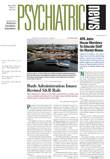New images of the metabolic activity of the brain have identified particular regions of the cortex and thalamus that “light up” when an alcoholic patient views pictures of alcoholic beverages. Moderate, nonalcoholic drinkers do not experience the same increase in brain activity when shown the same visual images, according to a study in the April Archives of General Psychiatry.
Lead investigator Mark S. George, M.D., a distinguished professor of psychiatry, neurology, and radiology and director of the Center for Advanced Imaging Research at the Medical University of South Carolina (MUSC), and his fellow researchers used functional magnetic resonance imaging (fMRI) to determine whether alcohol cues stimulate specific brain regions. Functional MRI imaging allows researchers to measure and track glucose utilization in brain tissue, thereby monitoring metabolic activity in response to particular stimuli.
The research is among the first reports using fMRI to image the areas of the brain implicated in the craving for alcohol. Other reports have previously documented an association between increased activity in particular areas of the brain and other substances of abuse, such as cocaine.
The current report describes specific areas of the prefrontal cortex and the anterior thalamus, areas that have been associated with emotion regulation, attention, and appetite-seeking behaviors. In alcoholic subjects, these areas showed increased activity when subjects were shown pictures of alcoholic beverages.
Nonalcoholic moderate drinkers did not show the same increase in metabolic activity; however, the researchers cautioned that it is too early to say that the areas of the brain identified in the study are responsible for the craving of alcohol.
“The regions activated in this study should not yet be interpreted as correlates of craving per se,” said George.
The activated regions are known to be associated with attention and regulating emotion and are prominent components of the working models of alcohol craving, noted Enoch Gordis, M.D., director of the National Institute on Alcohol Abuse and Alcoholism, which funded the research. “Whether the activity in these areas accompanies craving or is in part responsible for it remains to be determined.”
“Our goals were to learn whether certain brain areas would be activated for the alcohol cues but not for neutral cues and whether brain areas in alcoholic [individuals] would be activated differently from those of moderated drinkers,” said Raymond F. Anton, M.D., scientific director of MUSC’s NIAAA-funded Alcohol Research Center. Anton said the current report shows that certain brain regions were clearly activated in alcoholic individuals, but only with alcohol-specific cues. “It appears that the alcoholic subjects paid greater attention to the alcohol images,” Anton told reporters at a press conference announcing the findings.
“This work confirms a significant biological and brain component to alcoholism and provides information toward understanding the differences between alcoholic and nonalcoholic individuals,” said George. “Our next project will use fMRI scans to measure subjective craving in real time so that we can relate subjective craving temporarily to the presentation of visual cues.”
An abstract of the study, “Activation of Prefrontal Cortex and Anterior Thalamus in Alcoholic Subjects on Exposure to Alcohol-Specific Cues” is posted on the Web at http://archpsyc.ama-assn.org/issues/v58n4/abs/yoa9468.html. Additional research information on alcohol is posted at the NIAAA’s site at www.niaaa.nih.gov. ▪
